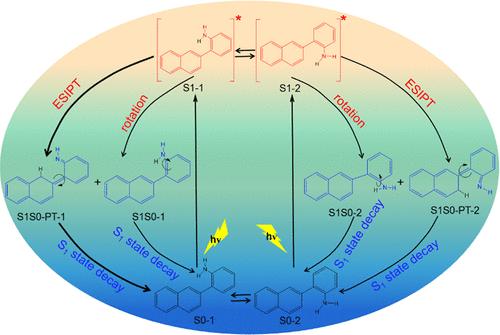当前位置:
X-MOL 学术
›
J. Phys. Chem. A
›
论文详情
Our official English website, www.x-mol.net, welcomes your feedback! (Note: you will need to create a separate account there.)
Mechanistic Insights into the Excited-State Intramolecular Proton Transfer (ESIPT) Process of 2-(2-Aminophenyl)naphthalene
The Journal of Physical Chemistry A ( IF 2.7 ) Pub Date : 2024-05-06 , DOI: 10.1021/acs.jpca.4c00532 Jiahui Wu 1 , Xinyu Zhang 1 , Jinglin Xia 2 , Zihao Zhou 1 , Shu-Hua Xia 1
The Journal of Physical Chemistry A ( IF 2.7 ) Pub Date : 2024-05-06 , DOI: 10.1021/acs.jpca.4c00532 Jiahui Wu 1 , Xinyu Zhang 1 , Jinglin Xia 2 , Zihao Zhou 1 , Shu-Hua Xia 1
Affiliation

|
The 2-(2-aminophenyl)naphthalene molecule attracted much attention due to excited-state intramolecular proton transfer (ESIPT) from an amino NH2 group to a carbon atom of an adjacent aromatic ring. The ESIPT mechanisms of 2-(2-aminophenyl)naphthalene are still unclear. Herein, the decay pathways of this molecule in vacuum were investigated by combining static electronic structure calculations and nonadiabatic dynamics simulations. The calculations indicated the existence of two stable structures (S0–1 and S0–2) in the S0 and S1 states. For the S0–1 isomer, upon excitation to the Franck–Condon point, the system relaxed to the S1 minimum quickly, and then there exist four decay pathways (two ESIPT ones and two decay channels with C atom pyramidalization). In the ESIPT decay pathways, the system encounters the S1S0-PT-1 or S1S0-PT-2 conical intersection, which funnels the system rapidly to the S0 state. In the other two pathways, the system de-excited from the S1 to the S0 state via the S1S0–1 or S1S0–2 conical intersection. For the S0–2 structure, the decay pathways were similar to those of S0–1. The dynamics simulations showed that 75 and 69% of trajectories experienced the two ESIPT conical intersections for the S0–1 and S0–2 structures, respectively. Our simulations showed that the lifetime of the S1 state of S0–1 (S0–2) is estimated to be 358 (400) fs. Notably, we not only found the detailed reaction mechanism of the system but also found that the different ground-state configurations of this system have little effect on the reaction mechanism in vacuum.
中文翻译:

2-(2-氨基苯基)萘激发态分子内质子转移 (ESIPT) 过程的机理见解
2-(2-氨基苯基)萘分子由于从氨基NH 2基团到相邻芳环的碳原子的激发态分子内质子转移(ESIPT)而引起了广泛关注。 2-(2-氨基苯基)萘的ESIPT机制仍不清楚。在此,通过结合静态电子结构计算和非绝热动力学模拟来研究该分子在真空中的衰变路径。计算表明在S 0和S 1状态下存在两个稳定结构(S0–1 和S0–2)。对于S0-1异构体,当激发到Franck-Condon点时,系统很快弛豫到S 1最小值,然后存在四个衰变路径(两个ESIPT路径和两个C原子金字塔化的衰变通道)。在ESIPT衰变路径中,系统遇到S1S0-PT-1或S1S0-PT-2圆锥形交叉点,这使系统快速进入S 0状态。在另外两条路径中,系统通过 S1S0–1 或 S1S0–2 圆锥形交叉点从 S 1去激励到 S 0状态。对于S0-2结构,衰变路径与S0-1相似。动力学模拟表明,S0-1 和 S0-2 结构分别有 75% 和 69% 的轨迹经历了两个 ESIPT 圆锥形相交。我们的模拟表明,S0–1 (S0–2) 的 S 1 态寿命估计为 358 (400) fs。值得注意的是,我们不仅发现了该体系的详细反应机理,而且还发现该体系的不同基态构型对真空中的反应机理影响很小。
更新日期:2024-05-06
中文翻译:

2-(2-氨基苯基)萘激发态分子内质子转移 (ESIPT) 过程的机理见解
2-(2-氨基苯基)萘分子由于从氨基NH 2基团到相邻芳环的碳原子的激发态分子内质子转移(ESIPT)而引起了广泛关注。 2-(2-氨基苯基)萘的ESIPT机制仍不清楚。在此,通过结合静态电子结构计算和非绝热动力学模拟来研究该分子在真空中的衰变路径。计算表明在S 0和S 1状态下存在两个稳定结构(S0–1 和S0–2)。对于S0-1异构体,当激发到Franck-Condon点时,系统很快弛豫到S 1最小值,然后存在四个衰变路径(两个ESIPT路径和两个C原子金字塔化的衰变通道)。在ESIPT衰变路径中,系统遇到S1S0-PT-1或S1S0-PT-2圆锥形交叉点,这使系统快速进入S 0状态。在另外两条路径中,系统通过 S1S0–1 或 S1S0–2 圆锥形交叉点从 S 1去激励到 S 0状态。对于S0-2结构,衰变路径与S0-1相似。动力学模拟表明,S0-1 和 S0-2 结构分别有 75% 和 69% 的轨迹经历了两个 ESIPT 圆锥形相交。我们的模拟表明,S0–1 (S0–2) 的 S 1 态寿命估计为 358 (400) fs。值得注意的是,我们不仅发现了该体系的详细反应机理,而且还发现该体系的不同基态构型对真空中的反应机理影响很小。








































 京公网安备 11010802027423号
京公网安备 11010802027423号